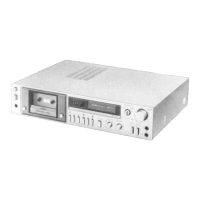dbx
Noise Reduction
System
The dbx Noise Reduction
System
serves to
greatly
reduce the
noise
generated
during recording and
playback
across
the
whole audible
frequency
spectrum
(reduction
by more than
about 30 dB) and also to
improve
the linearity at high input
levels. As
a
result,
both
recording
and
playback
can be
performed
without impairing the wide
dynamic range of the
original sound
There are two
kinds
of dbx Noise Reduction
System:
type I and type
II. Type I is used for
open-reel
decks
and
industrial
applications
while Type
II, which is featured in
this deck, is used for cassette applications.
Features
1 Reduced
noise
over the whole audible frequency range
(more
than about
30
dB reduction).
2 The
noise is
compressed at a high recording level for
recording to enable recording with minimal
distortion and a
wide dynamic
range.
3.
The linear logarithmic
compression and expansion do not
make the
sound
quality
undergo change with level mis-
matching.
Principle of basic
operation
The dbx system works to
expand the dynamic range
by com-
pressing (encoding)
the signals
and then expanding
(decoding
them As shown in
the
figure,
the input
signal level is halved
during recording
onto the tape. During
playback
the halved
level is
doubled
to
restore the original
signal.
The figure
shows
that
high
signals are
greatly
expanded
(from
"+10d8"
to
"
+20" dB)
while low signals are
given
a
low
expansion
(
"
-40
dB"to"-80d8"
)
This results
in a
great
improvement in
the
dynamic range and
simultaneously in a
great
reduction in tape
h
iss.
lnput Encoding Decoding
Output
ttt4d44fi/u^r,1l{{
Tape hiss
Expansion
in
Dynamic Range
The
figure
below shows the
dynamic
range
characteristics
First the overall
frequency
response is
indicated at a signal
level where
the distortion is made
3% al l
kHz.
When the
"dbx
in"
position
is selected,there
is an
increase
of about"l3dB"at
the 3%
point
over the
"out"
posrtion,
indicating
that the
distortion
with high input
levels is
greatly
improved.
ln addition, the
noise
distribution
is indicated
at the "dbx in"
"dbx
out"
positions
when the noise
level
is recorded without
any signals being supplied and that
noise
on the tape is
played
back.
With recording and
playback
at the
"dbx
in"
position,
it is
clear
that the noise level is
greatly
reduced.
Because
of the
great
reduction in
the noise level
and the
great
expansion in
the
signal
level, the
dynamic
range
at the
"dbx
in"
position
is vastly
improved,
and a dynamic
range
which is vastly
superior to that
ol a2-lrack
38 cm/sec. open-reel tape is
yielded.
Notes:
oThere
is no
compatibility between the dbx Noise
Reduction
Systems and other similar systems Tapes
recorded
with the
dbx
system should
therefore
be
played
back with
the dbx
system.
oRecord
ordinary
discs
(not "dbx
encoded
discs") with
the noise
reduction
selector
switch at
any
position
except
"disc".
The
sound
quality
will change if
this
switch is set to
the
"disc"
position
for
ordinary record
play
+2AdB
0dB
\
r
ape saru
level
alton
+zadB
0dB
rt0dB
0dB
2AdB
-z
'l0dB
2AdB
40d
B
30d
a
40d a
40d
B
60d
B
Tape
hiss
60d B
80d
B
80dB
Encoding/decoding
process

